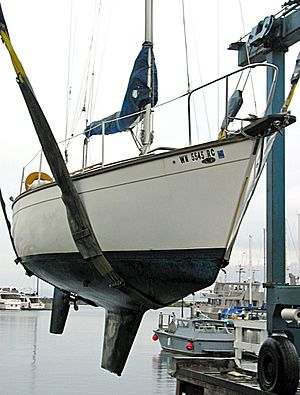Boat keel facts for kids
The keel is a very important part of a boat or ship. It's like the backbone of the vessel, running along the bottom, right in the middle. When a new ship is being built, the first big step is often laying down the keel. This date is usually marked as the official start of the ship's construction!
Contents
History of Keels
Keels have been around for a very long time! People have found signs of early wooden keels in many places across the world. For example, in Europe, archaeologists have discovered ancient Viking longships that were buried. Even after all these years, you can still see their keels and learn how these amazing boats were put together.
Did you know that the idea of an adjustable keel, called a centerboard keel, might have come from ancient China? During the medieval Song Dynasty, many Chinese junk ships used special keels. These keels were made of wooden beams held together with strong iron hoops. This clever technology helped Song dynasty ships become very useful in naval battles.
Types of Keels
There are different types of keels, depending on the boat's size and what it's used for.
Flat Plate and Bar Keels
The most common type of keel is the "flat plate keel." You'll find this kind on large ocean-going ships and many other big vessels. For smaller boats, like fishing trawlers, tugboats, or small ferries, a "bar keel" is often used. This type is thicker and more like a solid bar.
Keels for Non-Sailing Boats
Even boats that don't use sails need a keel! For these boats, the keel helps the hull move straight forward. Without it, the boat might slip sideways, especially in windy conditions. The keel sticks out from the bottom of the boat, helping it stay on course. There are many designs, including full keels, long keels, and fin keels.
Keels for Yachts and Sailboats
On sailboats and yachts, the keel does two very important jobs. First, it helps turn the sideways push of the wind on the sails into forward movement. Think of it like a fin that helps the boat slice through the water. Second, the keel is made of heavy materials, like lead or iron. This weight helps to keep the boat stable and upright, stopping it from tipping over too much when the wind blows hard.
Keels are different from centreboards. A centerboard can be pulled up or lowered, but a keel is usually a fixed part of the boat. However, some modern racing yachts have special keels that can move! These are called "canting keels." They can swing sideways to help the boat go even faster, especially in races like the Volvo Ocean Race.



